

Mesozoic. The Mesozoic era /mɛzɵˈzoʊɪk/ is an interval of geological time from about 252 to 66 million years ago.
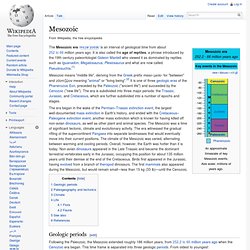
It is also called the age of reptiles, a phrase introduced by the 19th century paleontologist Gideon Mantell who viewed it as dominated by reptiles such as Iguanadon, Megalosaurus, Plesiosaurus and what are now called Pseudosuchia.[1] The era began in the wake of the Permian–Triassic extinction event, the largest well-documented mass extinction in Earth's history, and ended with the Cretaceous–Paleogene extinction event, another mass extinction which is known for having killed off non-avian dinosaurs, as well as other plant and animal species. The Mesozoic was a time of significant tectonic, climate and evolutionary activity.
Triassic. The Triassic began in the wake of the Permian–Triassic extinction event, which left the Earth's biosphere impoverished; it would take well into the middle of the period for life to recover its former diversity.
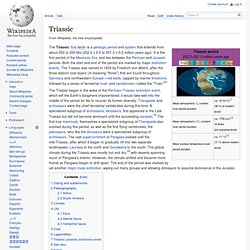
Therapsids and archosaurs were the chief terrestrial vertebrates during this time. A specialized subgroup of archosaurs, dinosaurs, first appeared in the Late Triassic but did not become dominant until the succeeding Jurassic.[5] The first true mammals, themselves a specialized subgroup of Therapsids also evolved during this period, as well as the first flying vertebrates, the pterosaurs, who like the dinosaurs were a specialized subgroup of archosaurs.
The vast supercontinent of Pangaea existed until the mid-Triassic, after which it began to gradually rift into two separate landmasses, Laurasia to the north and Gondwana to the south. The global climate during the Triassic was mostly hot and dry,[6] with deserts spanning much of Pangaea's interior. Dating and subdivisions[edit] Jurassic. Etymology[edit] The chronostratigraphic term "Jurassic" is directly linked to the Jura Mountains.
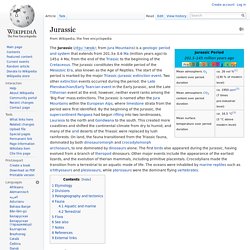
Alexander von Humboldt recognized the mainly limestone dominated mountain range of the Jura Mountains as a separate formation that had not been included in the established stratigraphic system defined by Abraham Gottlob Werner, and he named it "Jurakalk" in 1795.[4][5][6][7] The name "Jura" is derived from the Celtic root "jor", which was Latinised into "juria", meaning forest (i.e., "Jura" is forest mountains).[5][6][8] Divisions[edit] Key events in the Jurassic An approximate timescale of key Jurassic events. Various dinosaurs roamed forests of similarly large conifers during the Jurassic period.
Paleogeography and tectonics[edit] Dinosaur. Dinosaurs are a diverse group of animals of the clade Dinosauria. They first appeared during the Triassic period, 231.4 million years ago, and were the dominant terrestrial vertebrates for 135 million years, from the beginning of the Jurassic (about 201 million years ago) until the end of the Cretaceous (66 million years ago), when the Cretaceous–Paleogene extinction event led to the extinction of most dinosaur groups at the close of the Mesozoic Era.
The fossil record indicates that birds evolved from theropod dinosaurs during the Jurassic Period and, consequently, they are considered a subgroup of dinosaurs by many paleontologists.[1] Some birds survived the extinction event that occurred 66 million years ago, and their descendants continue the dinosaur lineage to the present day.[2] Etymology Definition The common House Sparrow (Passer domesticus) is often used to represent modern birds in definitions of the group Dinosauria General description Distinguishing anatomical features.
Mammal. Bird. Modern birds are characterised by feathers, a beak with no teeth, the laying of hard-shelled eggs, a high metabolic rate, a four-chambered heart, and a lightweight but strong skeleton.
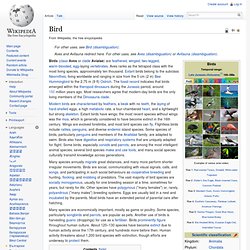
Extant birds have wings; the most recent species without wings was the moa, which is generally considered to have become extinct in the 16th century. Wings are evolved forelimbs, and most bird species can fly. Flightless birds include ratites, penguins, and diverse endemic island species. Some species of birds, particularly penguins and members of the Anatidae family, are adapted to swim. Birds also have digestive and respiratory systems that are uniquely adapted for flight. Many species are economically important, mostly as game or poultry. Evolution and classification Definition. Cretaceous. The Cretaceous (/krɨˈteɪʃəs/, krə-TAY-shəs), derived from the Latin "creta" (chalk), usually abbreviated K for its German translation Kreide (chalk), is a geologic period and system from circa 145 ± 4 to 66 million years (Ma) ago.
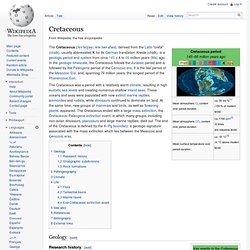
In the geologic timescale, the Cretaceous follows the Jurassic period and is followed by the Paleogene period of the Cenozoic era. It is the last period of the Mesozoic Era, and, spanning 79 million years, the longest period of the Phanerozoic Eon. Geology[edit] Key events in the Cretaceous An approximate timescale of key Cretaceous events. Research history[edit] Stratigraphic subdivisions[edit]